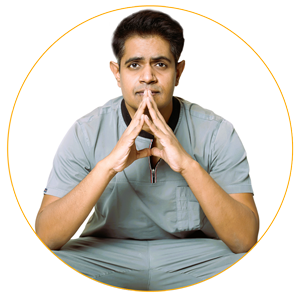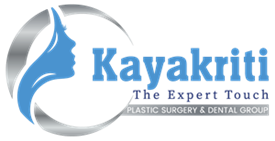Bilateral Sagittal Split Osteotomy (BSSO)
BSSO surgery has proven to improve any abnormalities of the face significantly.

Best Bilateral Sagittal Split Osteotomy (BSSO) surgery in India
What is Bilateral Sagittal Split Osteotomy (BSSO)?
Bilateral Sagittal Split Osteotomy (BSSO) is a type of orthognathic surgery in which the lower jaw is separated from the rest of the face and is repositioned-
- Backward.
- Forward.
- Upward.
- Downward.
Location of Bilateral Sagittal Split Osteotomy (BSSO)?
In BSSO, the lower jaw can be set forward (if it is too far back), backward (if it is too far forward), or set straight (if tilted to one side). Since it is an intraoral surgery, there is no visible scar on the patient's face. With the advent of the BSSO procedure, a complex range of lower face deformities can be corrected. The reassembly of the entire facial complex is possible with the help of the BSSO procedure.
What can you expect during the BSSO Surgery?
BSSO surgery has proven to improve any abnormalities of the face significantly. It requires proper diagnosis & planning by the operating surgeon. From treating misaligned bite defects to traumatic cases, an individual can improve his/her facial profile by corrective jaw surgery.
This is a corrective jaw surgery for conditions of the lower jaw or lower face related to structure, growth, and airway issues including
- Obstructive sleep apnea,
- Temporo-Mandibular Joint disorders,
- Malocclusion problems primarily arise from skeletal disharmonies,
- Orthodontic dental bite problems that can't be easily treated with braces
- A broad spectrum of facial deformities, where aesthetic improvement can be considered to improve self-esteem.
- Speech defects and in cases of trauma.
In severe deformities of the face, it can be combined with Le Fort Osteotomy. When BSSO is combined with LeFort Osteotomy, it is called Bi Jaw/Bi Max surgery.
BSSO is routinely combined with chin surgery/genioplasty.
Timing of Bilateral Sagittal Split Osteotomy Surgery
- Before performing orthognathic surgery, it is important to check that the skeletal growth is complete in both boys and girls which is usually 15 to 16 years in girls and 17 to 18 years in boys.
- There is variation in the growth of both upper & lower jaws. So the growth of both the jaws needs to be first assessed before performing the orthognathic surgery.
Planning for Bilateral Sagittal Split Osteotomy
Preoperative surgical planning is the key to successful surgery
Investigations
- 3D CT scan of the face
- Frontal and lateral photos of the face
- Cephalometric X-Ray of the face for soft tissue and bony measurements.
- Dental impressions are obtained to aid in formulating a diagnosis.
Out of all the mentioned investigations, Cephalometric X-rays are very important as it reveals abnormal growth patterns of the upper and lower jaws concerning the cranial base.
B) Analysis
Then a detailed analysis of the skeletal, dental, and soft tissue findings is done by Dr. Amit Agarwal and the orthodontist. Dental models are made and a mock surgery is performed on the model and acrylic occlusal splints are fabricated. These occlusal splints are used intraoperatively to accurately reposition the cut (osteotomized) mandible.
C) Presurgical Orthodontic Treatment
In many cases, pre-surgical orthodontic treatment for about 7 to 10 months is required, which may be continued after the surgery depending on the case requirement.
Contraindications for Bilateral Sagittal Split Osteotomy
- Major medical comorbidities.
- Cardiac diseases.
- Presence of active dental infections.
- A patient in the active growth phase.
- Psychiatric diseases or uncontrolled seizure disorders.
- The major difference between patients' and surgeons' goals and expectations.
- Patients with a habit of smoking and substance abuse.
- Questionable blood supply of the mandible as seen in multiple times operated patients or patients with a history of radiation therapy.
10 Steps for Surgical Procedure of Bilateral Sagittal Split Osteotomy
- This procedure is performed under general anesthesia with nasal endotracheal intubation. Local anesthesia (lidocaine 1% with 1:100,000 epinephrine) is also used to decrease blood loss.
- An opening of about 3 inches is made inside the mouth on the jaw just behind & to the side of the patient's last teeth of the lower jaw.
- Since the opening is inside the mouth there is no chance of an external scar.
- This opening gives access to the back part of the jaw which needs to be separated.
- A cut is made along the top & side edges of the jaw. These cuts will make a broad overlap of bone between the cut surfaces.
- The surgeon makes cuts behind the last molar teeth diagonally and lengthwise down the jawbone so the front of the jaw can move as one unit.
- The cuts are made on the sides-right and left. 'Osteotomes' which are the separators, are used to split the jaw through these cut edges.
- To establish an improved bite, the protruding jaw can be moved backward or a retruded lower jaw can be moved forward.
- Therefore, once the jaws are separated, the lower jaw can be moved to its corrected position and fixed through screws & plates, with intraoral wiring done on the teeth for better positioning of the lower jaw in proper occlusion/bite.
- The incision is closed in layers with absorbable sutures
The jaws are not wired & shut for long, and the segments are fixed rigidly.
Recovery period in BSSO
The patient is wheeled out of the operation theatre in stable condition and kept in the post-operative recovery room for overnight monitoring. Facial swelling and bruising are common after this surgery which surely subsides within a week. Ice packs may be applied in the early postoperative period to minimize swelling.
- Soft diet for 4 to 6 weeks starting with liquids for about a week.
- Antibiotic treatment is continued for one week.
- Soft elastics are placed between the upper and the lower jaw to hold the lower Jaw in the new position.
- The patient is usually discharged after 3 to 4 days from the hospital and is instructed to follow up after a week
- Early postoperative occlusal changes which may be due to edema and muscular re-adaptation are common.
- The patient is to follow a strict postoperative regimen
- Thorough oral hygiene is critical with the use of a soft toothbrush and antibacterial mouth rinse.
The main role of postsurgical orthodontics is to settle teeth into their final occlusion. The length of postoperative orthodontic treatment will vary, depending on the presurgical setup, the accuracy of planned surgical movements, and the final occlusal result. A general goal by most orthodontists is to complete all postsurgical orthodontics within 9 months.
As the swelling subsides, the patient can move his/her jaw to a greater degree. Rubber Band Therapy may also be advised to guide the lower jaw into the upper jaw.
BSSO & Distraction Osteogenesis
Patients with significantly underdeveloped mandibles like in craniofacial microsomia undergo two staged Bilateral Sagittal Spit Osteotomy (BSSO) with Distraction Osteogenesis. Patients who require the advancement of more than a centimeter to improve their facial profile and to correct their alignment of teeth, greatly benefit from distraction. Chances of relapse are very less in distraction osteogenesis as compared to single-stage BSSO advancement.
The majority of patients with severe mandibular hypoplasia are considered for BSSO with Distraction Osteogenesis. In such cases, BSSO is done and the mandible is separated from the native bones but is not advanced. An internal or external distractor is fixed to both the segments to gradually bring the lower jaw (mandible) forwards daily after the surgery.
Distraction can be of 2 types- Internal & External
- This procedure is performed under general anesthesia with nasal endotracheal intubation. Local anesthesia (lidocaine 1% with 1:100,000 epinephrine) is also used to decrease blood loss.
- In case of internal distraction, the internal distraction systems are buried underneath the mucosa & are activated between 4 to 5 days after surgery (bone is advanced in forwarding direction) & kept underneath for about 4 to 6 weeks after which the system is removed.
- In the case of an external fixator, the fixator device is secured to the cranium (head) during the activation period. A splint is attached to the mandible. The activation interval is the same as that of the internal fixator.
What are the risks and complications of Bilateral Sagittal Split Osteotomy
Bilateral Sagittal Split Osteotomy is a safe and reliable surgery but can lead to few complications which are described below-
- Bleeding.
- Infective complications such as Abscess formation
- Anterior open bite in the early or late postoperative period
- Dental and periodontal injuries
- Unfavorable fracture
- Partial or total nerve injury to the inferior alveolar nerve with sensory loss to the lower lip and teeth
- TMJ dysfunction or condylar malposition
- Non-union of bony segments
- Malocclusion- If the etiology of the malocclusion is related to improper placement of the mandible, failed hardware, or condylar malposition, revision surgery is indicated.
- Retraction of the gingiva.
Know your surgeon better

Best plastic surgeon, Dr. Amit Agarwal is an American Board Certified, extensively trained, and best Plastic & Aesthetic surgeon in Lucknow. He is the Chief Plastic Surgeon heading the Department of Plastic, Microvascular, and Craniofacial surgery at Vivekananda Polyclinic and Institute of Medical Sciences, Lucknow, U.P, India. He maintains a busy practice at Avadh and Nishat Hospital and his own center - Kayakriti Plastic Surgery & Dental Center. He was formerly a Consultant in the Department of Plastic Surgery and Burns at the prestigious SGPGI, Lucknow.
MS, DNB (General Surgery) MCh, DNB (Plastic Surgery),
MNAMS, FACS, FICS, FRCS (Edinburgh, UK)
His Credentials
Three pillars of kayakriti
Privacy
We believe your experience with us should be comfortable and hassle-free to make it one of your best lifetime experiences for yours. We, here at the clinic, take full precautions to maintain your privacy in any manner. We also provide a staff who will receive you from the gate and take you to the chamber directly if you demand.
Trust
Our Surgeon is highly qualified and internationally certified with a team of skilled staff to perform any surgical or non-surgical treatment on your body.
Safety
When you plan to undergo any surgery you should always keep in mind that it's your body and it's a surgery. We, here always keep your safety a priority and will never recommend you to undergo any such procedure which is not safe for you. We also provide you with a detailed description of the complications which may occur after the surgery during the consultation as it's a surgical procedure so there may be some complications depending on the way your body reacts.
Kayakriti in news



Frequently Asked Questions
If you have flat or small breast and you want to improve your breast and hip contour ratio then you are a good candidate for it. The answer will be best provided after the first consultation with Dr Amit Agarwal.
Acute pain will be there for almost a week which gradually reduces and there will be soreness and swelling which may take up to 3 weeks to subside.
You can join your work and daily routines after a week of the procedure and can start exercising after 3 weeks of it.
Yes, you have to wear it round the clock unless we suggest you to remove it.
This surgery does not affect the ducts or the areas of the breast involved in milk production. Thus, it does not affect the breast feeding.
This surgery does not affect the ducts or the areas of the breast involved in milk production. Thus, it does not affect the breast feeding.












Kayakriti Plastic Surgery & Dental Center
D-43, Near Punjab National Bank, Rajajipuram, Lucknow, Uttar Pradesh - 226017, India
Phone No. +919695940009, +919695940006
Map Location





























Social Media Presence